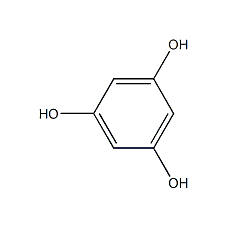Phloroglucinol Phloroglucinol


Structural formula
| Business number | 02XT |
|---|---|
| Molecular formula | C6H6O3 |
| Molecular weight | 126.11 |
| label |
Phlorizinol, Phloroglucinol, dihydrate, Phloroglucinol anhydrous, pyrogallol, 1,2,3-Trihydroxybenzene, gallicol, Pyrogallic acid, Phloroglucinol ts, Phloroglucin, Phloroglucinol, 1,3,5-Trihydroxy-benzen, 1,3,5-Trihydroxycyclohexatriene, 5-Oxyresorcinol, 5-Oxyresorcinolphloroglucin |
Numbering system
CAS number:108-73-6
MDL number:MFCD00002286
EINECS number:203-611-2
RTECS number:SY1050000
BRN number:1341907
PubChem number:24898169
Physical property data
1. Properties: white or light yellow crystalline powder. [1]
2. Melting point (℃): 218[2]
3. Boiling point (℃): sublimation [3]
4. Relative density (water = 1): 1.46[4]
5. Relative vapor density (Air=1): 4.3[5]
6. Heat of combustion (kJ/mol): -2657.2[6]
7. Octanol/water partition coefficient: -0.19[7]
8. Solubility: slightly soluble in water, soluble in ethanol, ether, and benzene. [8]
Toxicological data
1. Acute toxicity: rat oral LD50: 4mg/kg; rat intraperitoneal LD50: 3180mg/kg; rat subcutaneous LD50: 4850mg/kg; mouse oral LD50: 4550mg/kg; mouse Intraperitoneal LD50: 4050mg/kg; subcutaneous LD50 in mice: 991mg/kg; intravenous LDLo in dogs: >250mg/kg;
2. Reproductive toxicity: subcutaneous TDLo in rats: 5mg/kg (female 1 day after mouse conception);
3. Mutagenic yeast cell gene conversion and mitotic recombination test: 3mg/L; Cytogenetic analysis of hamster ovary: 3mg/L;
4. Acute toxicity[9] LD50: 5200mg/kg (rat oral)
Ecological data
1. This substance is slightly harmful to water.
2. Ecotoxicity[10]
LC50: 630mg/L (48h) (Fish)
EC50: 0.6mg/L (48h) (Daphnia)
IC50: 200mg/L (72h) (Algae)
3.Biodegradability No data available
4. Non-biodegradability No data available
Molecular structure data
1. Molar refractive index: 31.89
2. Molar volume (cm3/mol): 84.7
3. Isotonic ratio��� (90.2K): 252.3
4. Surface tension (dyne/cm): 78.6
5. Polarizability (10-24cm3): 12.64
Compute chemical data
1. Reference value for hydrophobic parameter calculation (XlogP): None
2. Number of hydrogen bond donors: 3
3. Number of hydrogen bond acceptors: 3
4. Number of rotatable chemical bonds: 0
5. Number of tautomers: 5
6. Topological molecule polar surface area 60.7
7. Number of heavy atoms: 9
8. Surface charge: 0
9. Complexity: 63.3
10. Number of isotope atoms: 0
11. Determine the number of atomic stereocenters: 0
12. Uncertain number of atomic stereocenters: 0
13. Determine the number of chemical bond stereocenters: 0
14. Number of uncertain chemical bond stereocenters: 0
15. Number of covalent bond units: 1
Properties and stability
1. Stability[11] Stable
2. Incompatible substances [12] Strong oxidants, strong acids, acid chlorides, acid anhydrides
3. Conditions to avoid contact[ 13] Light and heat
4. Polymerization hazard[14] No aggregation
Storage method
Storage Precautions[15] Store in a cool, ventilated warehouse. Keep away from fire and heat sources. The packaging must be sealed and must not come into contact with air. They should be stored separately from oxidants, acids, and food chemicals, and avoid mixed storage. Equipped with the appropriate variety and quantity of fire equipment. Suitable materials should be available in the storage area to contain spills.
Synthesis method
2,4,6-trinitrobenzoic acid is reduced with tin particles to obtain 2,4,6-triaminobenzoic acid. The dilute solution is heated to reflux for 20 hours, acidified with hydrochloric acid, and cooled to crystallize to obtain phloroglucinol. The yield is 46-53%.
Purpose
1. Determination of antimony, arsenic, cerium, chromate, chromium, gold, iron, mercury, nitrite, osmium, palladium, tin, vanadium, vanillin and lignin, etc., determination of furfural, pentose, polysaccharide, etc. Pentosyl, methanol, chloral hydrate, turpentine, hydrochloric acid in lignified cell tissue and gastric juice, decalcification of bone specimens.
2. Used as biological reagents for the preparation of dyes, drugs, resins, and for testing vanillin, lignin, and determination of uronic aldehydes, polypentosides, etc. [16]
